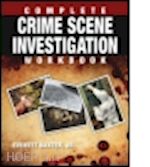This specially developed workbook can be used in conjunction with the Complete Crime Scene Investigation Handbook (ISBN: 978-1-4987-0144-0) in group training environments, or for individuals looking for independent, step-by-step self-study guide. It presents an abridged version of the Handbook, supplying both students and professionals with the most critical points and extensive hands-on exercises for skill enhancement. Filled with more than 350 full-color images, the Complete Crime Scene Investigation Workbook walks readers through self-tests and exercises they can perform to practice and improve their documentation, collection, and processing techniques.Most experienced crime scene investigators will tell you that it is virtually impossible to be an expert in every aspect of crime scene investigations. If you begin to "specialize" too soon, you risk not becoming a well-rounded crime scene investigator. Establishing a complete foundation to the topic, the exercises in this workbook reinforce the concepts presented in the Handbook with a practical, real-world application.As a crime scene investigator, reports need to be more descriptive than they are at the patrol officer level. This workbook provides a range of scenarios around which to coordinate multiple exercises and lab examples, and space is provided to write descriptions of observations. The book also supplies step-by-step, fully illustrative photographs of crime scene procedures, protocols, and evidence collection and testing techniques. This lab exercise workbook is ideal for use in conjunction with the Handbook, both in group training settings, as well as a stand-alone workbook for individuals looking for hands-on self-study. It is a must-have resource for crime scene technicians, investigators, and professionals who want a complete manual of crime scene collection and processing techniques.











